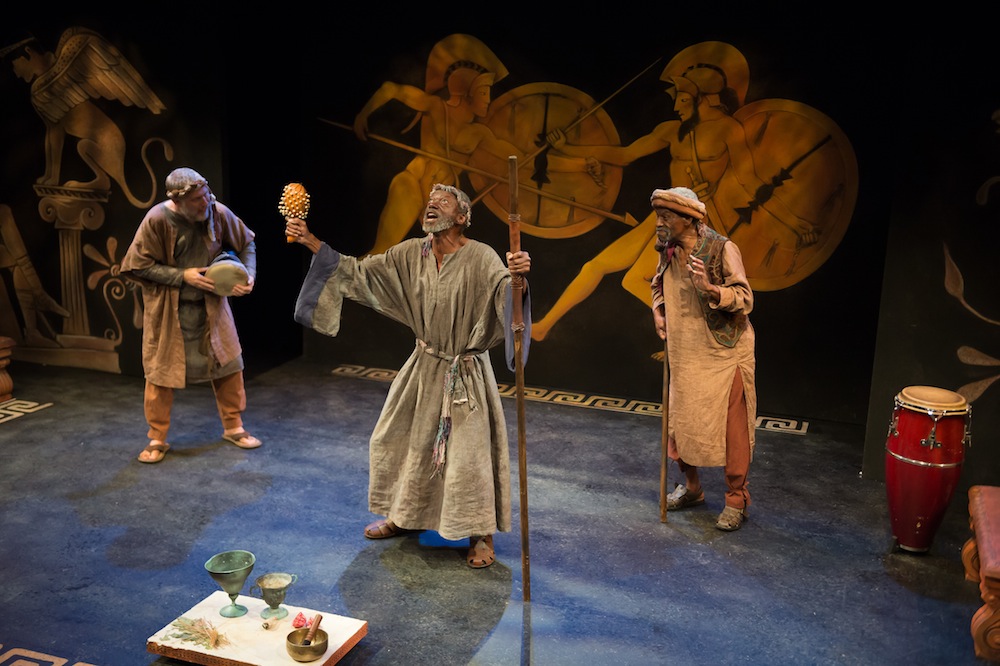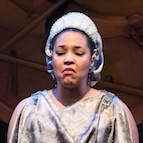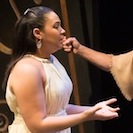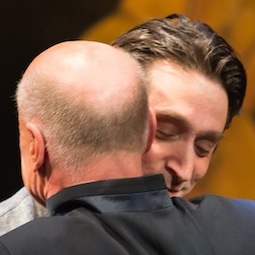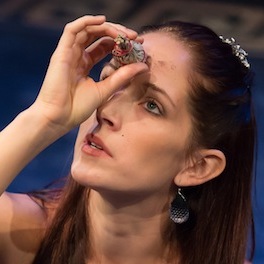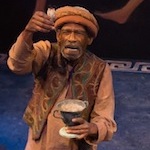Sophocles after Ferguson: Antigone in St. Louis, 2014
Timothy Moore
Washington University in St. Louis
As countless performances have shown, especially in the last fifty years, Greek tragedy in performance can respond to contemporary events in remarkably powerful ways.1 The intermingling of ancient drama and modern politics, however, often brings controversy. Some argue that productions that stay close to the text of the original and introduce few elements that jar with the allegedly ancient setting are academic and irrelevant. Meanwhile, productions that veer further from the original text and introduce conspicuous anachronisms are sometimes charged with losing track of the play at hand (Rehm 2003, 35–39, Goldhill 2007, 119–52).
Mary-Kay Gamel has recently provided a useful tool for directors and critics in working our way through these controversies, proposing that we evaluate productions in terms of what she calls “inductive authenticity” (Gamel 2010). After noting that attempts to provide alleged “authenticity” by recreating exactly the features of ancient performance are not only quixotic but can lead to productions so alien as to be meaningless to contemporary audiences, Gamel observes that there are aspects of ancient performance that we can recreate, but in our own terms. Among the most important of these is the political impact of the plays. Because ancient Athenian plays carried political messages relevant to the time of the original performances, Gamel argues, modern productions create their own form of authenticity when they engage with current politics.2 The productions Gamel praises for their “inductive authenticity” all include conspicuous anachronisms and some major modifications of the texts performed. Indeed, a strong case can be made that such productions recreate important elements of the politically engaged experiences of Athenian spectators. It should be remembered, however, that Athenian tragedy, unlike Old Comedy, usually engaged with contemporary politics implicitly rather than explicitly. In what follows I argue that productions can also accomplish Gamel’s “inductive authenticity” and engage with contemporary politics in meaningful and constructive ways while introducing minimal changes to their received texts and very few striking anachronisms. I offer as an example a 2014 production of Sophocles’ Antigone offered by the St. Louis-based Upstream Theater Company during a time of intense controversy and civil unrest in the St. Louis area (Boehm et al. 2014).
Philip Boehm, Artistic Director of Upstream Theater Company, chose for the opening show of his 2014–2015 season David Slavitt’s translation of Antigone (Slavitt 2007, 1–58). The play was to be performed in October 2014 at the Kranzberg Arts Center in central St. Louis. Perhaps more than any other Greek tragedy, Antigone cries out for engagement with contemporary politics, for the conflict between Antigone and Creon involves the proper relationship of the individual and the state, an issue that is always relevant. One thinks, for example, of Anouilh’s adaptation of the play, first performed in Nazi-occupied Paris; of Brecht’s passionately anti-fascist Antigone; and of Athol Fugard’s The Island, where a “play-within-the play” Antigone comments on Apartheid.3
As Upstream Theater’s production was in its early design stages, the issues raised in Antigone suddenly became far more urgent. On August 9, 2014, Michael Brown, an unarmed black man, was shot to death by police officer Darren Wilson in Ferguson, Missouri, a suburb of St. Louis less than 10 miles from the theater where Antigone was to be performed. The shooting led to many nights of riots in Ferguson, protests and riots elsewhere in the St. Louis area and throughout the United States, and considerable debate and soul-searching within and beyond St. Louis about race, social justice, civil disobedience, and police violence.4
Antigone has much to say to anyone pondering Michael Brown’s death and its aftermath. The play’s conflict between the individual and the state’s need for order became intensely relevant when a representative of the state in charge of maintaining public order killed an unarmed citizen; and that conflict continued to resound emphatically as police clashed with protestors in the days, weeks, and months that followed. Furthermore, the saga of Ferguson, like the plot of Antigone, started with an exposed corpse. The turmoil over Michael Brown’s death began as his body lay for four hours on the street where he had been killed. Though defended by the police on logistical grounds, the long delay in removing Brown’s body was widely considered a willful failure to handle a victim of police action with dignity and an affront to the community observing the body’s treatment.5
Boehm was therefore faced with important choices as he prepared his production. He could ignore the events in Ferguson, allowing the resonances between the play and contemporary events in St. Louis to speak for themselves, or he could adjust the production to respond to what was happening in the St. Louis area. If he chose to respond to what was going on outside the theater, he would need to decide what aspects of the Sophoclean play he thought relevant to St. Louisans in late 2014, and how to bring those aspects to the fore.
Boehm chose to respond to the events surrounding him in a way that was unobtrusive yet quite effective. His general approach was in most ways traditional. He made very few changes to Slavitt’s text, and though he did not seek any pedantic “authenticity,” the production’s set, costumes, and props could with only a few exceptions pass for “Greek” to the non-expert. Boehm did, however, make one very conspicuous addition to the plot: he began the performance not with Sophocles’ dialogue between Antigone and Ismene, but with Polyneices’ body lying on stage. This opening allusion to current events in St. Louis would encourage audience members to keep those events in mind as they responded to the rest of the play. Boehm also decided, while not ignoring the individual struggle between Antigone and Creon, to give particular attention to the community in which that struggle occurs, emphasizing that mythical Thebes, like St. Louis in 2014, was a community in crisis. Finally, Boehm chose to place special focus on Creon as a figure of authority alienated from his community, thus emphasizing important parallels between the Theban ruler and authority figures in the St. Louis region in 2014.
The Corpse
The first thing Boehm’s audience saw was the body of Polyneices lying on a half-lit stage.6 The stage remained in semi-darkness as Antigone (Maggie Conroy) entered, sprinkled ashes on the body, and left (image 1).7 Few in the audience would miss the allusion to Michael Brown, as for over two months news sources had been reminding them repeatedly of the long time Brown’s body lay in the street on August 9th.8 Audience members would therefore be primed to draw analogies between Thebes and Ferguson as the performance continued.
Boehm’s opening scene also reinforced the relevance of the play to what became for many a dangerous “red herring” in debates in St. Louis and elsewhere in the weeks after Michael Brown’s death: Brown’s character. Rumors swirled in the fall of 2014 about just what kind of a person Michael Brown was and what he was up to when he was apprehended and then shot. In fact, it was revealed, Brown had robbed a convenience store shortly before he encountered Wilson. In the weeks when Antigone was performed, St. Louis and the nation waited for the results of a grand jury investigation into the shooting. As they did so, many noted that the personal guilt or innocence of Brown and of Wilson was less important than what the tragic events of August 9th revealed about the state of St. Louis and America, and the need for St. Louis and all cities to address racial inequalities, violence in law enforcement, and other systematic problems.9 Antigone provides a powerful tool for confronting this issue, as Creon and Antigone debate whether our own moral imperative to do right is affected by the guilt of others:
CREON: Eteocles was blood-kin, too, remember.
ANTIGONE: Yes, of the same mother, the same father.
CREON: How then can you insult his memory?
ANTIGONE: He will not bear witness or take offense.
CREON: No? If you honor his enemy—a traitor?
ANTIGONE: Polyneices was my brother. Not some slave.
CREON: He attacked the city Eteocles defended!
ANTIGONE: Even so, there are honors due the dead.
CREON: For the just and the unjust? The good and the wicked?
ANTIGONE: In the world below, who knows what was good or evil?
CREON: Enemies don’t change, not even in death.
ANTIGONE: I was not born to feud but to love and to honor. (512–523, Slavitt 23–24)
Creon sees only Polyneices’ wrongdoing. For Antigone, her duty to the dead outweighs any concerns about the morality of the deceased.
The play also reveals that however guilty Polyneices may have been, the treatment of his body brings pollution to the entire city. Tiresias says to Creon:
Our altars
are covered with foul bits the dogs and birds
have brought from Polyneices’ rotting corpse.
The gods, disgusted, no longer hear our prayers.
And the birds are driven crazy having feasted
on the clotted blood of the body you left for them. (1016–1022, Slavitt 2007, 44)
He adds later:
Then hear me, Creon. You shall not see the sun
make many circuits before you have to pay
corpse for corpse for those you have dishonored:
a dead man’s body left unburied, defiled
and therefore defiling…
You cannot
keep here what belongs to the gods below,
a corpse, unburied, obscene. (1064–1071, Slavitt 2007, 46)
Whatever we may decide about Polyneices’ guilt or innocence, his unburied corpse showed that something was very wrong in Thebes, just as the body of Michael Brown lying so long in the street revealed that things were not right in St. Louis and America, regardless of what we decide about Brown’s character and the murky chain of events that preceded his death on August 9th. By adding the body and the burial to the opening of the play, Boehm provided a powerful reinforcement of this message.
Communities in Crisis
The play-opening corpse was one of several ways in which Upstream Theater’s Antigone underlined that the crisis of the play engulfed not just Antigone and Creon, but Thebes as a whole, in ways that paralleled the ongoing crisis in the region and nation where the play was performed. In his program notes, Boehm wrote, “While it would be wrong to suggest a direct correspondence, recent tragic events in our city lend unwanted resonance to this ancient tragedy. With Antigone, Sophocles reminds us of the psychological devastation that comes in the wake of every social disaster. The question remains: how do we seek collective catharsis?” (Boehm 2014a). In an interview with American Theatre shortly before the start of Antigone’s run, Boehm said: “We’re not after one-to-one correspondence with the events in Ferguson—I think that would be wrong and inappropriate. The underlying issue of the play is a conflict between society’s need for law and order and an individual’s need to follow her conscience, but we’re also interested in exploring the psychological devastation all these social disasters carry with them. The wreckage is enormous and the collective psyche is scarred.” (Weinert-Kent 2014).
The backdrop to Upstream Theater’s Antigone gave visual emphasis to the community’s troubles, calling attention to two aspects of crisis shared by mythical Thebes and 2014 St. Louis: violence and a curse that transcends generations.10 It consisted of three panels (image 2). The large central panel showed two warriors in hand-to-hand combat. The warriors, who could be assumed to be Eteocles and Polyneices, provided a stark and continual reminder of the violence that lay behind the plot, violence that was to be relentlessly continued as the play proceeded. That reminder of recurring violence would be disturbingly familiar to the play’s audience. Michael Brown’s death led to more violence in the riots that followed (Brown 2015), and by the time of Antigone’s run there had been more controversial deaths of black men at the hands of police in St. Louis and elsewhere. Within weeks of the play’s close, two police officers in New York City had also died at the hands of a sniper who claimed to be avenging Michael Brown and other victims of the police (Mueller and Baker 2014).11
Each of these acts of violence brought its own individual controversies and contexts. Yet all were emblematic of our peculiarly American version of a Greek tragic curse: the country’s long sordid history of racism, from which decades of civil rights legislation have been unable to free us. That wider context of the Ferguson and post-Ferguson violence brought special significance to the paintings on the side panels of the play’s set: each showed Oedipus and the sphinx. The side panels thus kept always before the audience’s eyes the story of Oedipus and the curse that his deeds had brought upon his family and his city, reinforcing the first words of the play:
ANTIGONE:
Dear sister, Ismene, what evils that come
From Oedipus our father has Zeus not sent
to burden our lives? (1–3, Slavitt 2007, 2)12
Oedipus and his curse, presented on the side panels, provided the context for the violence painted on the central panel, just as the curse of American racism provided the context for the violence in 2014 St. Louis.
Boehm’s presentation of the chorus further encouraged spectators to think about the play’s plot in the context of a community struggling in the midst of violence and strife, and to associate that community with their own. As a group of elders, the chorus members are representatives of the wider community beyond both those in authority, such as Creon, and those opposing authority, such as Antigone. Their position is therefore analogous to most members of the audience, who for this production were residents of the St. Louis region observing the events that unfolded after Michael Brown’s death. Sophocles portrays the chorus as closely aligned with the ruling class, advising Creon from a position of prestige. Boehm’s chorus (Dennis Lebby, Norman McGowan, and Patrick Siler), however, wore costumes reminiscent of pre-industrial people of the lower classes (image 4), costumes similar to those of Tiresias (John Bratkowski, image 5), and the messenger (Nancy Lewis, image 6), but in conspicuous contrast to the far finer garments of the members of the ruling family (see below).13 The costumes thus granted the chorus more of an “everyman” status than the text suggests, encouraging still further an identification between them and average St. Louisans. Although Boehm made no explicit allusions to race, his casting of the chorus as two black performers and a white performer brought racial diversity to his chorus, in contrast to the all-white cast of leads. In fact this casting reflected the demographics of Ferguson itself in October 2014, where the population of the city was about 70% black and about 30% white, but where the city government was almost entirely white (that situation changed with the election of more black officials in April 2015 [Eligon 2015]).
Boehm has stated that he sees Antigone’s chorus as “fickle in its own way,” changing its views in response to the arguments of the characters (Boehm 2015). During many scenes, Boehm divided his chorus, placing two actors on one side of the stage—and thus visually aligned with the actor arguing from that side—and a third member nearer the opposing actor on the other side of the stage (e.g., image 7). These divisions visually paralleled the deep divisions within the St. Louis community after Michael Brown’s death. When the chorus came together in their prologos and stasima, their movements were often highly erratic: both Sophocles’ words and their movements emphasized the chorus’ uncertainties about the crisis they were observing, uncertainties similar to the doubts and anxieties oppressing the people of St. Louis in the troubling times surrounding Antigone’s performance.14
Alienated authority
As the events following Michael Brown’s death unfolded, it became clear that a large part of the region’s and the nation’s problems stemmed from the failure of those in authority to connect with the communities they represented. Police and other authority figures, for reasons that were understandable but nevertheless unacceptable, found themselves tragically alienated from those they were supposed to serve. Whatever one decides about the specific circumstances surrounding the death of Michael Brown, few would doubt that his shooting was part of a pattern found throughout the United States in which police, eager to enforce the law, make questionable use of violence against members of minority groups. In the days and weeks following Michael Brown’s death, use of force by those in authority repeatedly antagonized citizens. In response to the riots, for example, police shocked many by entering Ferguson with over-the-top militarized equipment; and the arrest of numerous peaceful protesters, as well as reporters and political leaders, brought scandal and bad will (Brown 2015). This aspect of the Ferguson crisis inspired Boehm to call special attention to Creon and his alienation from the community he governed, and to encourage his audience to draw analogies between Creon and the police and other authorities of the St. Louis area.
A few weeks before the opening of his Antigone, Boehm presented his take on the play to the Classical Club of St. Louis. He entitled his presentation, “Should Sophocles’ Antigone Really Be Called Creon?” (Boehm 2014a). Boehm objects to the tendency, so comfortable in our age of individualism, for analyses and productions of Antigone to focus almost entirely on Antigone as the heroic resister of a completely unsympathetic tyrant. He has noted that during rehearsals he frequently discussed Creon’s viewpoint with the actors, asking them, for example, to ponder an Antigone set in a demolished town in Europe immediately after World War II, where survival depended upon the maintenance of order (Boehm 2015).15 Creon fails and he is at fault, but his failure and fault are understandable within his milieu. His failure is the failure of authority, made rigid by a crisis, alienated from its community. In discussing his production, Boehm stressed the universality of the dangers to which Creon succumbs, noting: “We are all prone to closing our minds and closing our ears” (Boehm 2015). Acting styles, costuming, blocking, and the use of props all reinforced this presentation of Creon, emphasizing his authority, his anxiety surrounding that authority, and his alienation from the other characters and the community of Thebes as a whole.
Peter Mayer as Creon relayed a mesmerizing combination of self-assurance and bluff throughout, clearly doing everything in his power to cover up his own doubts about the best course of action (image 9). One reviewer noted how the actors playing both Haemon (Andrew Michael Neiman) and the guard (John Bratkowski) showed the difficulty of penetrating Creon’s stony expression (Green 2014). Mayer had also played Creon when Upstream Theater performed Oedipus King in 2010 (image 10), so those who had seen that play would be struck by the irony of Creon’s obstinacy here when he had faced Oedipus’ stubbornness in the previous production: crisis and authority have changed him.
Creon’s anxiety surrounding his authority became especially clear in his scene with the guard. Bringing news of Polyneices’ burial, the guard entered carrying an exceptionally long spear (image 11; cf. Callahan 2014). The spear, in the hands of Creon’s minion, helped to demonstrate Creon’s overweening concern with his authority. Displaying the visual symbol of power through a subordinate was not enough for Creon, though: midway through his dialogue with the guard he got impatient and took the spear himself, and he held it through much of the rest of the scene (image 12).
In various ways the production underlined how this determination to maintain control alienates Creon from his community. We noted above the generically pre-industrial costuming of the chorus, Tiresias, and the messenger. Most of the other costumes were equally vague in their associations. Looking most “Greek” was the guard, whose costume included a tunic and a cuirass (image 11). Most members of the Theban royal family wore costumes that revealed their upper-class status without placing them in a specific cultural milieu: Eurydice (Wendy Renée Greenwood, image 13) and Haemon (image 14) wore elaborate robes, and Antigone (image 15) and Ismene (Wendy Renée Greenwood, image 16) dressed more simply but elegantly. Amidst these costumes, Creon’s outfit—part Maoist uniform and part business suit—stood out as looking peculiarly modern and indicative of a no-nonsense authority figure; and Creon, in contrast to the bare feet or sandals of all the other characters and his own bare feet in the earlier Oedipus King (image 10), wore a pair of sturdy black shoes (image 12). Several reviewers of the play noted the jarring disparity between Creon’s costume and the others’.16 The costume drew attention to Creon’s position of authority and, because it differed so much from the other costumes, to Creon’s alienation from his fellow citizens and his family. In the final scenes, as he returned with the body of Haemon, Creon had lost this symbol of his authority: he was shirtless, shoeless, and wore a pair of baggy brown pants instead of the elegantly cut blue pants that accompanied his jacket in the earlier scenes (image 17).
Actors’ movements drew further attention to how Creon’s determination to exercise his authority separated him from his community. The plot demands that Creon spend much of his time on stage in opposition to other characters. Boehm’s blocking amplified this opposition, as the audience repeatedly saw Creon at a distance from others on the stage (images 18, 19, 20). Alienation and authority joined together visually as first the guard (image 21) and then Haemon (image 22) knelt before Creon from across the stage.
Particularly striking is the way Boehm and his actors employed physical contact. Actress Maggie Conroy’s Antigone was nearly obsessive in touching her fellow actors. She caressed Polyneices while she buried him in the opening scene (image 1). It is no surprise that in their dialogue the sisters Antigone and Ismene touched each other often and ardently (e.g., image 23). More remarkable is how Antigone broke down the usual barriers between actors and chorus by touching members of the chorus frequently. She emphasized the contrast between her approach and Creon’s most effectively when she reached out to grasp one of the chorus members by the shoulder while accosting Creon (image 24). Later the messenger reporting the deaths of Antigone and Haemon mirrored Antigone’s behavior by touching chorus members (image 25).
In contrast to his antagonist and the reporter of his doom, Creon almost never touched another character, and others failed to reach him when they touched him. A desperate embrace of his father by Haemon (image 26) failed to have any effect: the two characters continued the scene in mutual consternation (image 27). When Tiresias attempted to get through to Creon with a warm hand on the shoulder, he was equally ineffective (image 28). Only late in the play, when he decided too late to heed Tiresias’ warning, did Creon touch a member of the chorus as he asked for advice (image 29).
Providing the most powerful messages about the importance of community, and Creon’s alienation from those around him, was a set of props that could be considered the signature feature of the production. Far downstage center, and therefore as far from the disturbing backdrop as one could get without leaving the playing area, was a small table containing a number of objects: two slices of pomegranate, ears of grain, and three vessels, one of which contained ashes, another burning incense (image 2). These objects resonated in various ways. Their significance was, on the one hand, cosmic. Boehm has noted that the table included representatives of each of the four Greek primordial elements—air, fire, water, and earth—and that the pomegranate and grain remind one of the myth of Persephone, and hence of death and the transcendence of death (Boehm 2015). The ashes would make the objects’ association with death clear even to those unfamiliar with Greek mythology. As much as they represented the cosmic, however, the objects also stood for the communal. It would be clear even to audience members unfamiliar with ancient Greek culture that the objects are of a type associated with ritual. To many spectators the association with ritual would be still more intense, as the connection of the grain and pomegranate with the myth of Persephone would remind them of the Eleusinian Mysteries. Ritual, especially in pre-modern cultures, is widely recognized as a key feature that joins together otherwise disparate groups of people, and the Eleusinian Mysteries were one of the most important unifying rituals of ancient Greece. The most important role of these objects, therefore, was as a symbol of what unites mythical Thebes as a community.
With these objects in the foreground, the entire stage became an area of negotiation between strife and a curse, represented by the images on the backdrop, and the sense of community embodied in the ritual objects downstage. The play was performed in a black-box theater, with audience members surrounding the stage on three sides. The table downstage center was thus the focal point not just of the stage but of the theater as a whole, and the contrast on stage between the objects representing community and the strife shown on the backdrop paralleled visually the audience’s own attempt to place community over differences in the strife beyond the theater.
Characters interacted with the objects throughout the play. Antigone performed two actions kneeling before the small table. She handled the pomegranate (image 30), and she painted her forehead with ashes (image 31), echoing her earlier sprinkling of ashes on Polyneices. Haemon also took hold of a slice of pomegranate, echoing Antigone’s earlier action (image 32). After pondering it, he squeezed it (image 33). After Eurydice heard the messenger report her son’s suicide, she stood in front of the table and removed her jewels (image 34); kneeling, she placed them on the table among the ritual objects (image 35).
Each of these characters was responding to the cosmic significance of the objects: handling pomegranate, painting themselves with ashes, and depositing jewels among the ashes and pomegranate slices, they foreshadowed their own deaths. At the same time, however, their close relationship with these items of communal ritual indicated their connection with the institutions of their community. When others characters engaged with the ritual objects, no implication of death was involved, so the emphasis was more specifically on the connection with the communal. At one point Tiresias bowed down directly before the table of ritual objects (image 36). At two moments in their songs, members of the chorus took hold of vessels from the table (images 37, 38).
Through most of the play, Creon remained aloof from the ritual objects, a conspicuous reminder that even as he seeks to maintain social cohesion by forbidding the burial of Polyneices, his response to his nephew’s death is in opposition to the values of the community he is trying to preserve. At several points Boehm’s blocking reinforced Creon’s separation from the objects and from his community, as the stage showed other characters near the table and distant from and opposed to Creon. At one point Antigone knelt before the objects, her back to Creon (image 39). At another she stood near the table facing Creon at a distance (image 40). Haemon likewise knelt at the table with his back to Creon (image 41), and Tiresias stood between the ritual objects and Creon (image 42). Only at the end of the play, when he had encountered disaster, did Creon approach the ritual objects. He entered the stage carrying the dead Haemon (image 43). He laid his son down directly in front of the table and grieved over him (image 44). Then, echoing the two earlier uses of ashes by Antigone, he took the vessel filled with ashes and sprinkled them first on Haemon (image 45) and then on himself (image 17). The close association of the ritual objects with this moment of deepest pathos brought home the extent to which Creon’s failure to connect with his community had brought about his own ruin.17
Upstream Theater’s Antigone, then, though very traditional in most respects, nevertheless encouraged audience members to connect the play with current controversies outside the theater. By beginning with Polyneices’ corpse, the Upstream Theater performances provided reminders of Michael Brown and at the same time reinforced the play’s message about how the need to right communal wrongs transcends individual guilt or innocence. The stage set, casting, costuming, and choral movements encouraged audience members to appreciate the relevance of Antigone’s and Creon’s conflict to the troubled city of Thebes as a whole and, by implication, to the troubled St. Louis region in 2014. Pre-production advertisement, acting styles, blocking, gesture, and the use of props further encouraged audience members to think about the role of authority within troubled communities. The production did not condemn Creon, just as it did not condemn the police and other authorities who were the objects of controversy in the world outside the theater in 2014. But it did drive home the dangers to a community when its authority figures become alienated and rigid, a message that was of great value in late-2014 St. Louis.18
Upstream Theater’s Antigone thus provides a case study of how Gamel’s standard of “inductive authenticity” can be met by more traditional productions as well as by those that make explicit allusions to current events. With or without such overt allusions, Greek tragedy in performance can play a vital role in contemporary debates.
notes
1 On the explosion of performances of Greek tragedy since the 1960s, many with explicit political messages, see Hartigan 1992, 67–146; McDonald 1992; Garland 2004, 179–85, 232; Hall 2004; Altena 2007; Foley 2012, 96–121, 132–89, 210–28 and passim.
2 Cf. Gamel 1999 27: “productions which openly engage with contemporary issues and values are not anachronistic or inauthentic. In fact, attention to such implications in twentieth-century [or twenty-first-century] performance of ancient scripts is actually closer to the conditions of ancient performance than approaches which focus only on the historical, aesthetic, or emotional dimensions of ancient scripts” (emphasis Gamel’s).
3 On performances of Antigone in the United States, see Hartigan 1992 112-18, Foley 2012 249-58 and passim. Both Hartigan and Foley note that earlier productions, where contemporary political implications of the play were largely ignored, have been replaced since the mid-twentieth century with productions more explicitly engaged with current politics.
4 For a timeline of the events from Michael Brown’s death through August 10, 2015, see Brown 2015. For an extensive collection of images, videos, and documents related to the events, see Washington University in St. Louis Libraries 2014.
5 The relevance of Antigone to post-Ferguson United States was brought home emphatically two years later, when Bryan Doerries and his Theater of War Productions presented “Antigone in Ferguson,” a staged reading of an abridged translation of Antigone supplemented by a gospel choir and followed by a long talk-back in which audience members related the play to contemporary events. “Antigone in Ferguson” opened in Ferguson in September 2016 and then travelled around the United States.
6 The “body” was a very still Andrew Michael Neiman, the actor who would later play Haemon. In the darkness, and because his back was to the audience, his identity was not evident, but his status as a real human body was. Boehm did not seek to recreate the exact position of Michael Brown’s body: Brown lay on his stomach, Neiman on his side.
7 All images of Upstream Theater’s production of Antigone are copyright ProPhotoSTL.com. The author thanks Peter Wochniak for permission to use these photos.
8 Cf. these words by one of the play’s reviewers (Allen 2014): “Creon makes the decree that, of two brothers recently killed in battle, only one will be honored and the other shall be left unburied on the battlefield to be feasted on by birds and animals. With the news recently that a young man killed in North County was left dead on the streets of Ferguson for a seemingly unnecessary length of time before being removed to the morgue, the irony across the ages cannot be overlooked.”
9 Ensuing events confirmed this perspective. About a month after Antigone closed on October 26th (November 24, 2014), a grand jury ruled not to indict Darren Wilson, and on January of the next year lawyers of the Federal Justice Department recommended that no civil rights charges be brought against Wilson (Apuzzo and Schmidt 2015). Less than two months after its lawyers recommended that Wilson not be charged, however (March 4, 2015), the Justice Department argued in a review of the Ferguson Police Department that the department had engaged widely in racially biased law enforcement (United States Department of Justice Office of Public Affairs 2015).
10 Scenic design by Michael Heil, paintings by James van Well (panels) and Cristie Johnston (stage).
11 The violence continued well after 2014, and by the time of the final revision of this article (January 2017), well-publicized incidents in several American cities had taken the lives of numerous minority civilians at the hands of police and numerous policemen at the hands of minority civilians.
12 The sphinx scene’s reminder of Oedipus would be especially strong for members of the audience who had seen Upstream Theater’s production of Oedipus Tyrannos, performed in the same space four years earlier (Boehm et al. 2010). In that production the exact same scene covered the stage itself (image 3).
13 The costumes were designed by LaLonnie Lehman.
14 Boehm has pointed out the important difference between Antigone’s chorus and us. The elders of Sophocles’ Thebes have no real power, and their advice has no effect on Creon until it is too late. Boehm has expressed his hope, which we can all share, that in our representative democracy our voices and our votes can help change the conditions that lay behind the crisis of 2014 (Weinert-Kent 2014).
15 Note also the image used on the program cover and in advertisements for the production. It showed the faces of Antigone and Creon juxtaposed, surrounded by the words, “What would you be willing to die for? What would you be willing to kill for?” (image 8). The inclusion of both questions sent the message that, in contrast to many productions of the play, Creon’s dilemma would be put on equal footing with Antigone’s.
16 “LaLonnie Lehman's costumes, with the odd exception of Creon's more modern attire, lend an air of authenticity” (Gibson 2014); “LaLonnie Lehman makes a bizarre costuming choice by depicting Creon in a suit and wearing shoes, while everyone else is barefoot or in sandals of ancient attire. Perhaps her intention is to single out Creon as deviating from the wishes of the populace and therefore looking ‘different’ than the others, a most jarring appearance” (Bretz 2014); “Costumes by LaLonnie Lehman are rather mixed; the chorus of elders are beautifully evocative of some ancient tribal place (north Africa? Afghanistan?). A guard in a bronze cuirass is straight out of classical Greece. Antigone wears a very modern dark dress and fashionable sandals with an ankle strap and low heels. King Creon appears in what might be a collarless Mao suit but for all the very shiny brass buttons. This all lends an air of confusion—of indecisiveness—which is a bit distracting” (Callahan 2014).
17 Creon sprinkling himself with ashes was the subject of a brief video, produced by Michael Dorsey and posted on Vimeo (Dorsey 2014: https://vimeo.com/108010549). A link to the video was sent in an email blast and otherwise distributed as one of the major ways of publicizing the production.
18 In keeping with these themes of community and the dangers of authority, Philip Boehm invited Shelly Welsch, mayor of University City, Missouri, to a talkback after one of Antigone’s performances (University City lies directly in between the location of the theater and Ferguson). Mayor Welsch, whose suburban St. Louis community faces some of the same challenges as Ferguson, discussed with members of the cast, Philip Boehm, and translator David Slavitt the need for flexibility on the part of those with power. Upstream Theater later brought its production to a prison near St. Louis. There the play’s attention to issues of authority, community, and violence was even more poignant.
works cited
Allen, Steve. 2014. “Approachable ‘Antigone’ Poses Old Questions but Hints at the Present at Upstream Theater.” Stage Door St. Louis, October 13, 2014. http://stagedoorstl.com/2014/10/13/approachable-antigone-poses-old-questions-but-hints-at-the-present-at-upstream-theatre/.
Altena, Herman. 2005. “The Theater of Innumerable Faces.” In A Companion to Greek Tragedy, edited by Justina Gregory, 472–89. Malden, MA: Blackwell.
Apuzzo, Matt and Michael S. Schmidt. 2015. “U.S. Not Expected to Fault Officer in Ferguson Case.” The New York Times, January 21, 2015. http://www.nytimes.com/2015/01/22/us/justice-department-ferguson-civil-rights-darren-wilson.html?_r=0.
Boehm, Philip. 2014. Program notes, Sophocles, Antigone. St. Louis: Upstream Theater Company.
______. 2014a. “Should Sophocles’ Antigone Really Be Called Creon?” Lecture, St. Louis Classical Club, September 20, 2014.
______. 2015. Interview with author, November 4, 2015.
______, et al. 2010. Sophocles, Oedipus King [theatrical production]. St. Louis: Upstream Theater Company, October 8–24, 2014.
______. 2014. Sophocles, Antigone [theatrical production]. St. Louis: Upstream Theater Company, October 10–26, 2014.
Bretz, Mark. 2014. “‘Antigone’ Resonates With Timeless Clarity.” Ladue News October 15, 2014. http://www.laduenews.com/diversions/arts-entertainment/antigone-resonates-with-timeless-clarity-theater-review/article_75971daa-5491-11e4-9766-0017a43b2370.html.
Brown, Emily (compiler). 2015. “Timeline: Michael Brown Shooting in Ferguson, Mo.” USA Today, August 10, 2015. http://www.usatoday.com/story/news/nation/2014/08/14/michael-brown-ferguson-missouri-timeline/14051827/.
Callahan, Steve. 2014. “Upstream Brings a Classic to the Kranzberg.” KDHX Community Media. St. Louis, October 13, 2014.
Dorsey, Michael. 2014. “Upstream Theater Presents ‘Antigone’” [online video]. Vimeo, uploaded by Cladogram Pictures. October 4, 2014. https://vimeo.com/108010549.
Eligon, John. 2015. “Ferguson Elects 2 Blacks to City Council, but Rejects Activist Candidates.” The New York Times, April 7, 2015. http://www.nytimes.com/2015/04/08/us/ferguson-adds-blacks-to-city-council-but-rejects-activist-candidates.html.
Foley, Helene P. 2012. Reimagining Greek Tragedy on the American Stage. Berkeley: University of California Press.
Gamel, Mary-Kay. 1999. “Staging Ancient Drama: The Difference Women Make.” Syllecta Classica 10: 22–42.
______. 2010. “Revising ‘Authenticity’ in Staging Ancient Mediterranean Drama.” In Theorising Performance: Greek Drama, Cultural History and Critical Practice, edited by Edith Hall and Stephe Harrop, 153–70. London: Duckworth.
Garland, Robert. 2004. Surviving Greek Tragedy. London: Duckworth.
Gay, Malcolm. 2014. “Antigone: Upstream Theater Delivers an Academic Telling of Sophocles' Classic.” Riverfront Times, Arts and Culture, October 15, 2014. http://www.riverfronttimes.com/artsblog/2014/10/15/antigone-upstream-theater-delivers-an-academic-telling-of-sophocles-classic.
Gibson, Chris. 2014. “BWW Reviews: Upstream Theater’s Masterful Production of ANTIGONE.” BroadwayWorld.com: St. Louis, October 15, 2014. http://www.broadwayworld.com/st-louis/article/BWW-Reviews-Upstream-Theaters-Masterful-Production-of-ANTIGONE-20141015.
Goldhill, Simon. 2007. How to Stage Greek Tragedy Today. Chicago: University of Chicago Press.
Green, Richard T. 2014. Review of Antigone, by Sophocles, directed by Philip Boehm, Upstream Theater. Talkin’ Broadway, Regional Reviews: St. Louis. http://www.talkinbroadway.com/page/regional/stl/stl371.html.
Hall, Edith. 2004. “Introduction: Why Greek Tragedy in the Late Twentieth Century?” In Dionysus Since 69: Greek Tragedy at the Dawn of the Third Millennium, edited by Edith Hall, Fiona Macintosh, and Amanda Wrigley, 1–46. Oxford: Oxford University Press.
Hartigan, Karelisa V. 1995. Greek Tragedy on the American Stage: Ancient Drama in the Commercial Theater, 1882–1994. Westport, CT: Greenwood Press.
McDonald, Marianne. 1992. Ancient Sun, Modern Light: Greek Drama on the Modern Stage. New York: Cambridge University Press.
Mueller, Benjamin, and Al Baker. 2014. “2 N.Y.P.D. Officers Killed in Brooklyn Ambush; Suspect Commits Suicide.” The New York Times, December 20, 2014. http://www.nytimes.com/2014/12/21/nyregion/two-police-officers-shot-in-their-patrol-car-in-brooklyn.html?_r=0.
Rehm, Rush. 2003. Radical Theatre: Greek Tragedy and the Modern World. London: Duckworth.
Slavitt, David R. (trans.). 2007. The Theban Plays of Sophocles. New Haven: Yale University Press.
United States Department of Justice Office of Public Affairs. 2015. “Justice Department Announces Findings of Two Civil Rights Investigations in Ferguson, Missouri.” Press release, March 4, 2015. http://www.justice.gov/opa/pr/justice-department-announces-findings-two-civil-rights-investigations-ferguson-missouri.
Washington University in St. Louis Libraries. 2014–. Documenting Ferguson. Digital collection. http://digital.wustl.edu/ferguson/.
Weinert-Kent, Rob. 2014. “Upstream Theatre's 'Antigone' Neither Avoids nor Exploits #Ferguson Echoes.” American Theatre Previews, October 10, 2014. http://www.americantheatre.org/2014/10/10/upstream-theatres-antigone-neither-avoids-nor-exploits-ferguson-echoes/

